Preliminary Multiphysics Modeling of Electric High-Voltage Cable of Offshore Wind-Farms
Abstract
:1. Introduction
1.1. Cable Design—Preliminary Notions
1.2. Numerical Model
- A model of a 6-wire helical single-layer conductor with a central core (Figure 2).
- A second model of a bilayer conductor with 6 helical wires in the first layer and 12 wires in the second layer (Figure 3)
2. Results and Discussion
2.1. Finite Element (EF) Model
2.2. Numerical Results
2.3. Conductor Geometry Type 1 + 6
2.4. Conductor Geometry Type 1 + 6 + 12
2.5. Influences of Some Variables on the Electrical Resistance of the Conductor
2.6. Effect of Friction
2.7. Pitch Length Effects
2.8. Effects of Progressive Wire Failure
2.9. FE Thermal and Thermoelectric Modeling
- ;
- are the dielectric losses in the insulator;
- is the conductor wire number;
- is the resistance of the conductor to an alternative current;
- is the dissipation factor of the screen;
- is the dissipation factor in the shield.
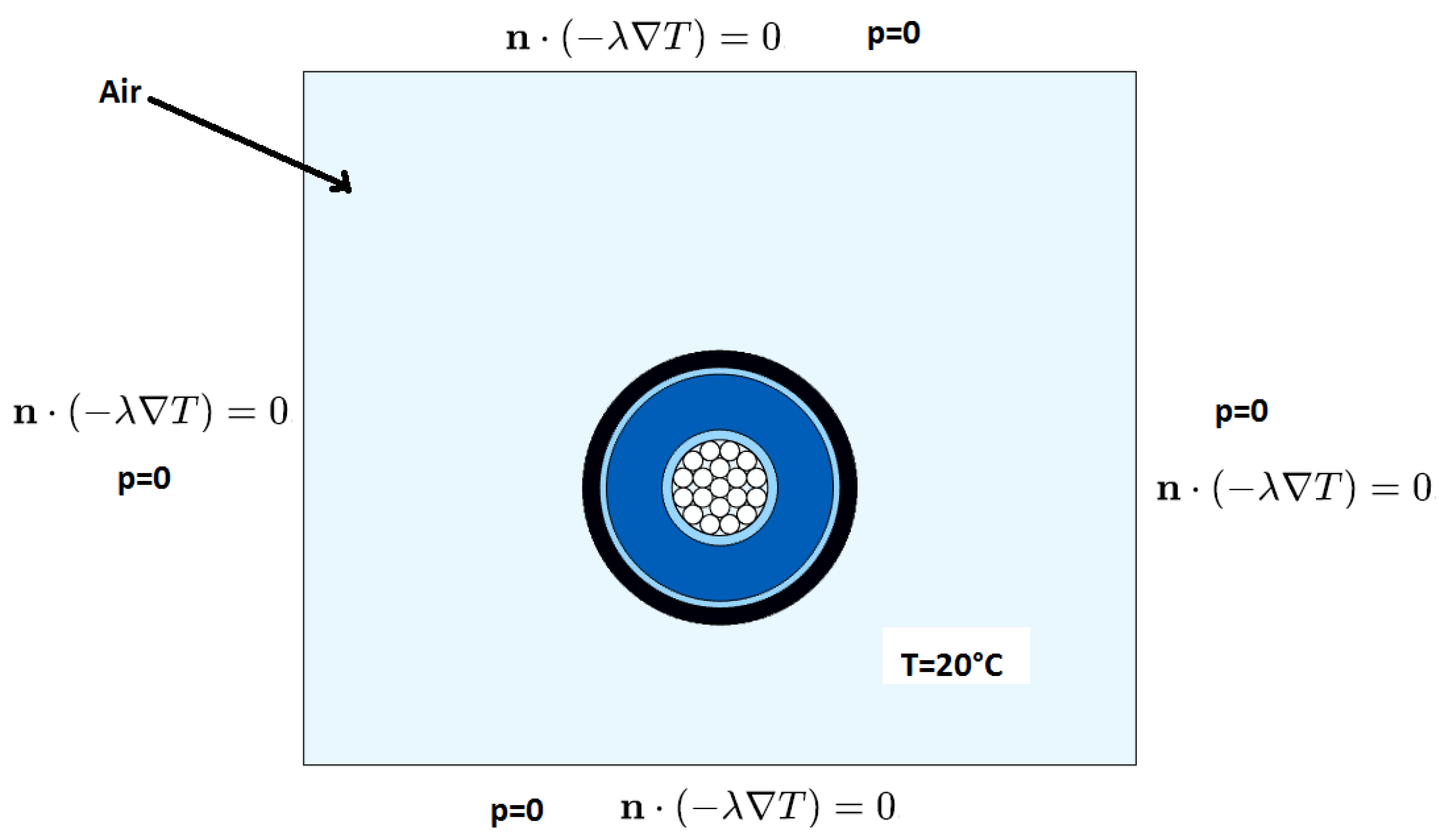
2.10. Numerical Results
2.11. Copper Plasticity Effects on the Cable Temperature
2.12. Effects of Wire Failures on Cable Temperature
3. Conclusions
Author Contributions
Funding
Data Availability Statement
Acknowledgments
Conflicts of Interest
References
- European Union Long-Term Strategy. Available online: https://energy.ec.europa.eu/topics/renewable-energy/renewable-energy-directive-targets-and-rules/renewable-energy-targets_en (accessed on 18 July 2023).
- Ech-Cheikh, F. Numerical and Analytical Modeling of the Mechanical and Multi-Physics Behavior of High-Voltage Phase of Offshore Electric Cable. Ph.D. Thesis, Ecole Centrale, Nantes, France, 26 January 2022. [Google Scholar]
- Matine, A.; Drissi-Habti, M. On-Coupling Mechanical, Electrical and Thermal Behavior of Submarine Power Phases. Energies 2019, 12, 1009. [Google Scholar] [CrossRef]
- Drissi-Habti, M.; Raman, V.; Khadour, A.; Timorian, S. Fiber Optic Sensor Embedment Study for Multi-Parameter Strain Sensing. Sensors 2017, 17, 667. [Google Scholar] [CrossRef] [PubMed]
- Drissi-Habti, M.; Raj-Jiyoti, D.; Vijayaraghavan, S.; Fouad, E.-C. Numerical Simulation for Void Coalescence (Water Treeing) in XLPE Insulation of Submarine Composite Power Cables. Energies 2020, 13, 5472. [Google Scholar] [CrossRef]
- Miceli, M.; Carvelli, V.; Drissi-Habti, M. Modelling Electro-Mechanical Behaviour of an XLPE Insulation Layer for Hi-Voltage Composite Power Cables: Effect of Voids on Onset of Coalescence. Energies 2023, 16, 4620. [Google Scholar] [CrossRef]
- Drissi-Habti, M.; Manepalli, S.; Neginhal, A.; Carvelli, V.; Bonamy, P.-J. Numerical Simulation of Aging by Water-Trees of XPLE Insulator Used in a Single Hi-Voltage Phase of Smart Composite Power Cables for Offshore Farms. Energies 2022, 15, 1844. [Google Scholar] [CrossRef]
- Drissi-Habti, M.; Neginhal, A.; Manepalli, S.; Carvelli, V.; Bonamy, P.-J. Concept of Placement of Fiber-Optic Sensor in Smart Energy Transport Cable under Tensile Loading. Sensors 2022, 22, 2444. [Google Scholar] [CrossRef] [PubMed]
- Drissi-Habti, M.; Neginhal, A.; Manepalli, S.; Carvelli, V. Fiber-Optic Sensors (FOS) for Smart High Voltage Composite Cables—Numerical Simulation of Multi-Parameter Bending Effects Generated by Irregular Seabed Topography. Sensors 2022, 22, 7899. [Google Scholar] [CrossRef]
- Abaqus Software. Available online: https://www.3ds.com/fr/produits-et-services/simulia/produits/abaqus/ (accessed on 18 July 2023).
- Comsol Multi-Physics Software. Available online: https://www.comsol.com/ (accessed on 18 July 2023).
- Available online: https://www.nexans.com/en/markets/power-generation/offshore-wind/NorthWind.html (accessed on 18 July 2023).
- IEC60287-1-1; Electric Cables—Calculation of the Current Rating—Part 1—1: Current Rating Equations (100% Load Factor) and Calculation of Losses—General. International Electrotechnical Commission: Geneva, Switzerland, 2006.
- Neber, J.H.; Mcgratb, M.H. The calculations of the temperature rise and load capability of cable systems. In Proceedings of the AIEE Summer General Meeting, Montreal, QC, Canada, 24–28 June 1957; Volume 76, pp. 1752–1772. [Google Scholar]
- Napieralski, P.; Juszczak, E.N.; Zeroukh, Y. Nonuniform Distribution of Conductivity Resulting from the Stress Exerted on a Stranded Cable During the Manufacturing Process. IEEE Trans. Ind. Appl. 2016, 52, 3886–3892. [Google Scholar] [CrossRef]
- Bonnet, A.M. Analyse des Solides Déformables par la Méthode des Éléments Finis; Ecole Polytechnique: Palaiseau, France, 2007. [Google Scholar]
- Francesco, F.; Luca, M. Mechanical modeling of metallic strands subjected to tension, torsion and bending. Int. J. Solids Struct. 2016, 91, 1–17. [Google Scholar]
- Liu, D.-S.; Ni, C.-Y. A thermo-mechanical study on the electrical resistance of aluminum wire conductors. Microelectron. Reliab. 2002, 42, 367–374. [Google Scholar] [CrossRef]
- Long, C. Essential Heat Transfer, 1st ed.; Longman: London, UK, 1999. [Google Scholar]
- Cable IEC Standards. Available online: https://www.elandcables.com/fr/electrical-cable-and-accessories/cables-by-standard/iec-cable (accessed on 18 July 2023).
- Raman, V.; Drissi-Habti, M. Numerical simulation of a resistant structural bonding in wind-turbine blade through the use of composite cord stitching. Compos. Part B Eng. 2019, 176, 107094. [Google Scholar] [CrossRef]
- Available online: https://eatechnology.com/americas/resources/faq/partial-discharge-testing-of-cables/ (accessed on 18 July 2023).
- Available online: https://www.powerandcables.com/partial-discharge-cableterminations/ (accessed on 18 July 2023).
- Available online: https://lectromec.com/addressing-the-big-questions-of-partial-discharge/ (accessed on 18 July 2023).
- Refaat, S.S.; Shams, M.A. A review of partial discharge detection, diagnosis techniques in high voltage power cables. In Proceedings of the 2018 IEEE 12th International Conference on Compatibility, Power Electronics and Power Engineering (CPE-POWERENG 2018), Doha, Qatar, 10–12 April 2018; pp. 1–5. [Google Scholar] [CrossRef]
- CIGRÉ Working Group B1.43. Recommendations for Mechanical Testing of Submarine Cables; CIGRÉ: Paris, France, 2015; ISBN 978-2-85873-326-2. [Google Scholar]
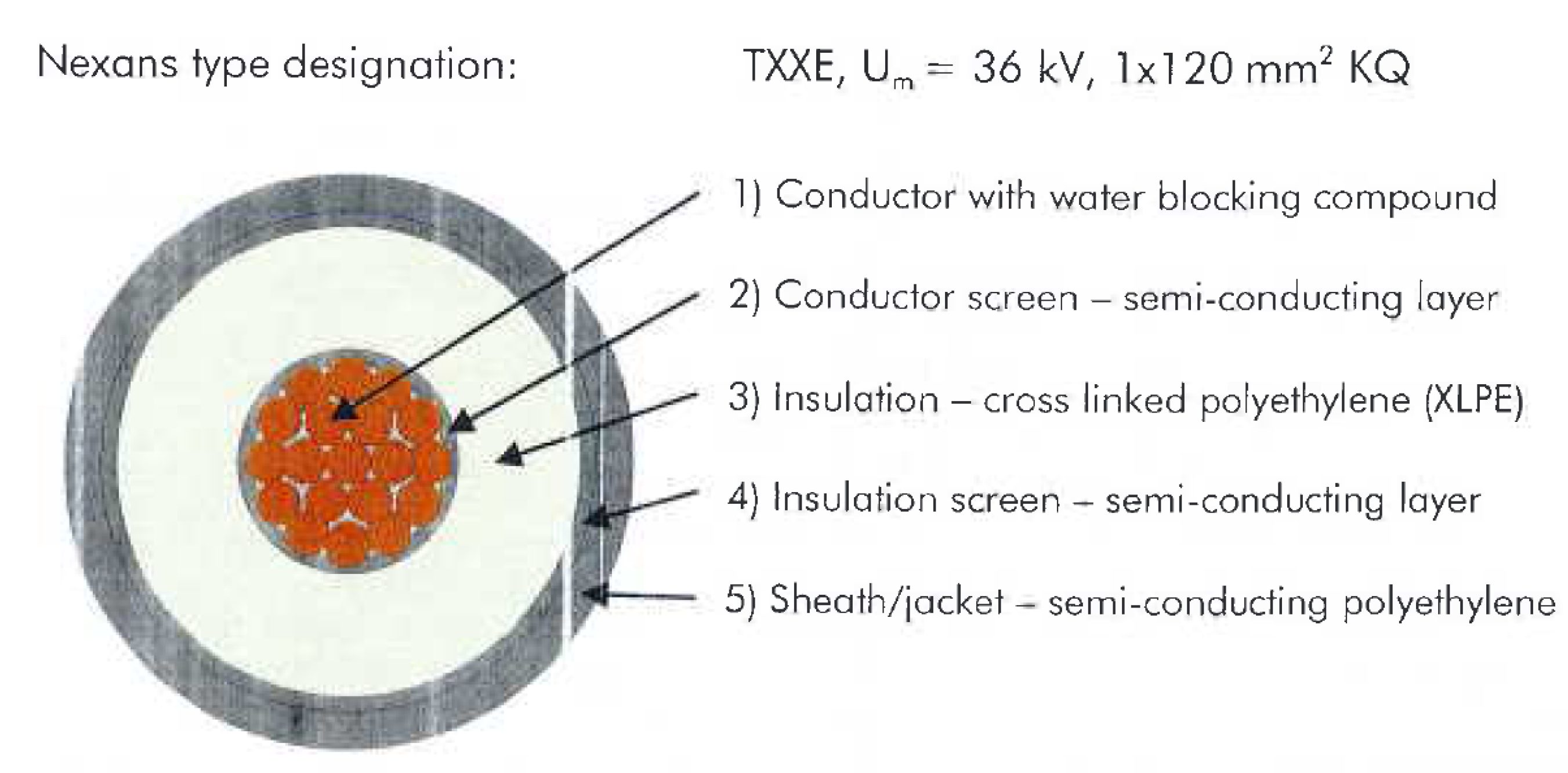





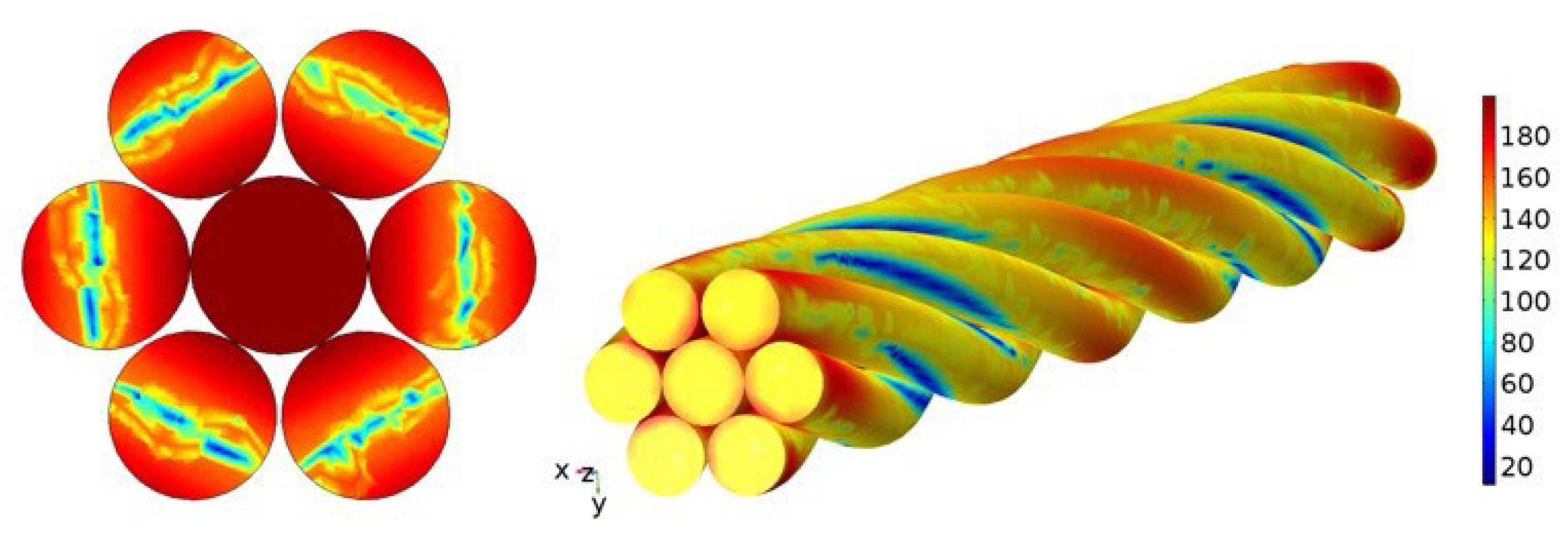



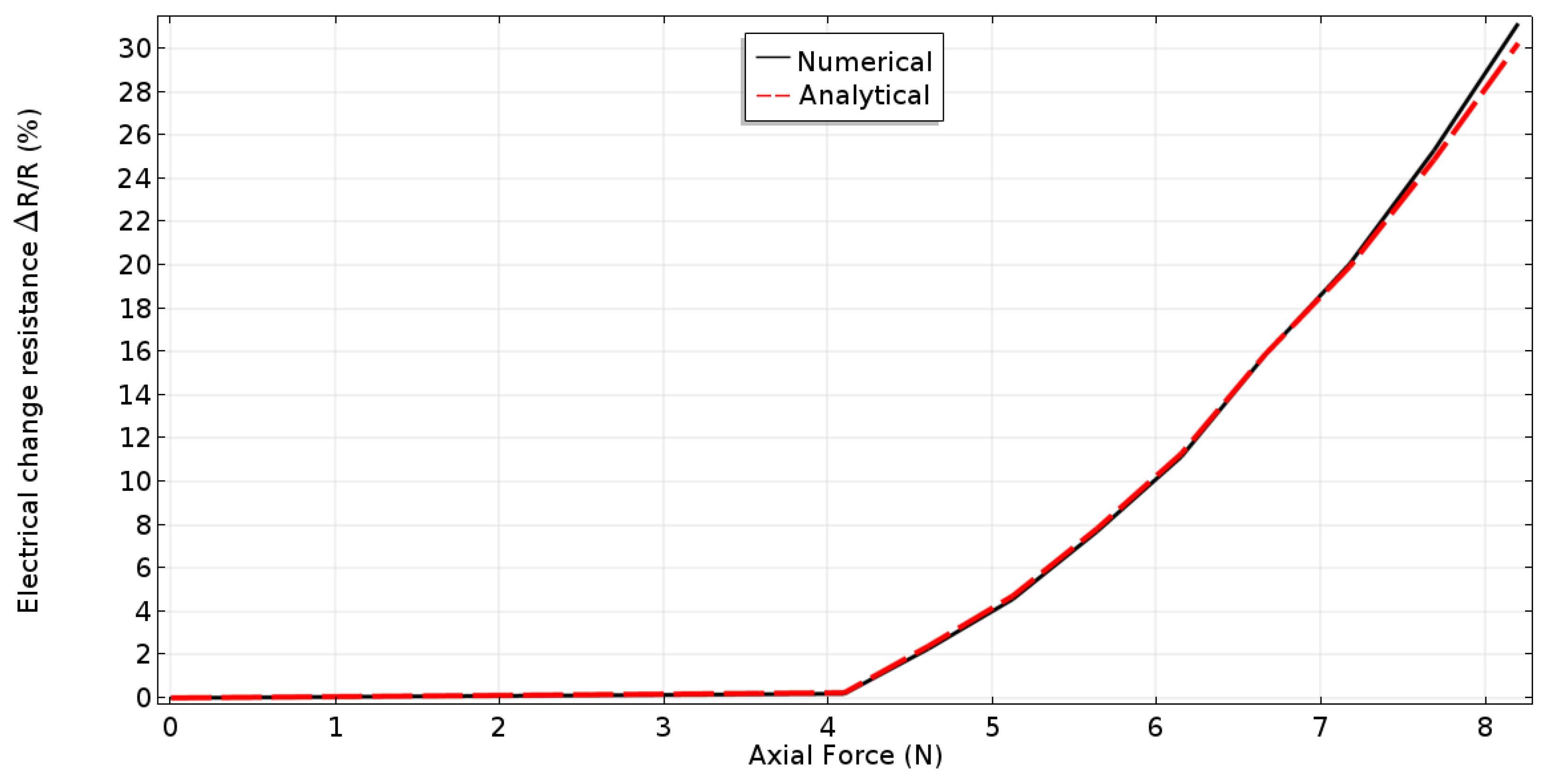







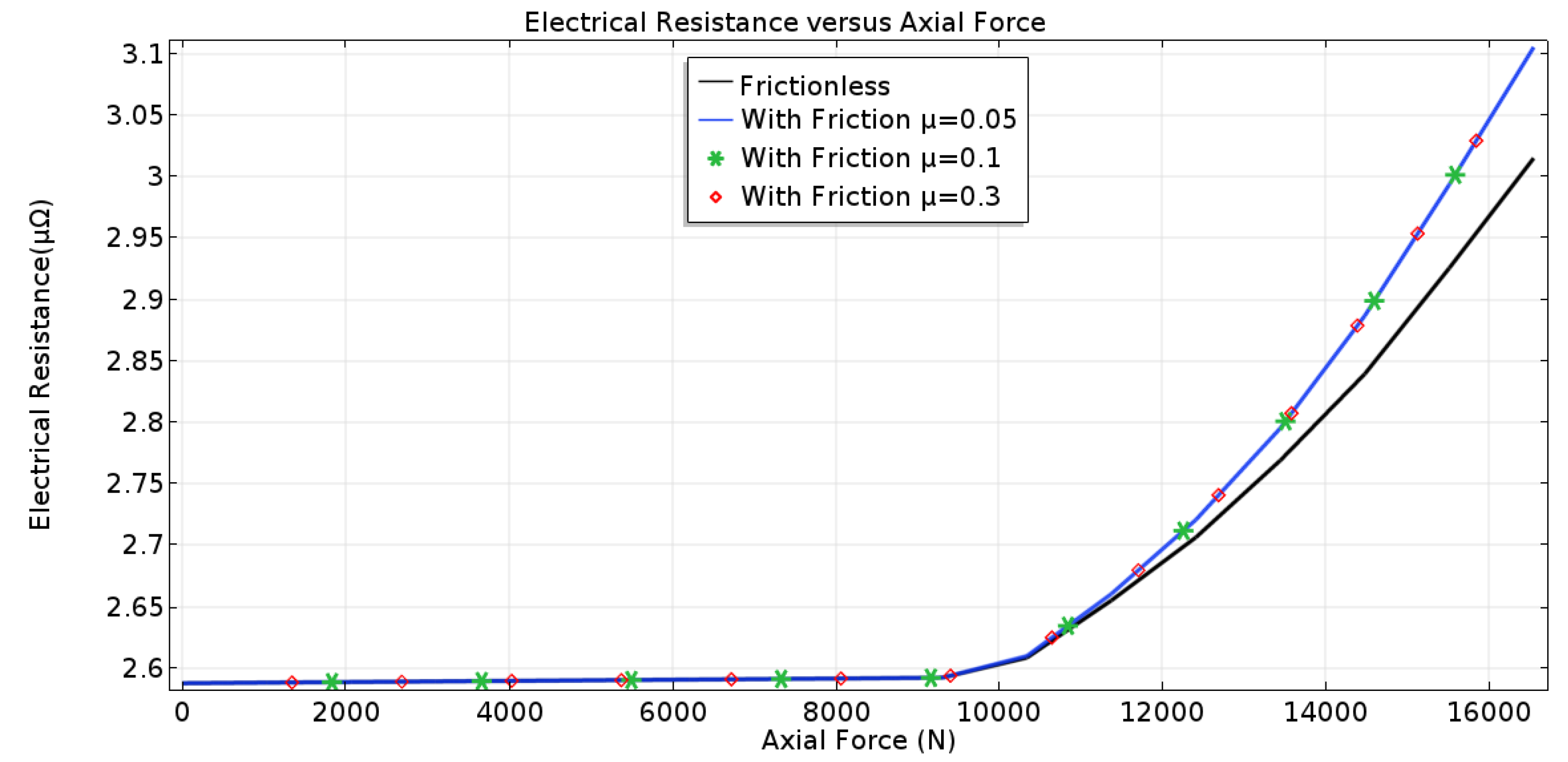


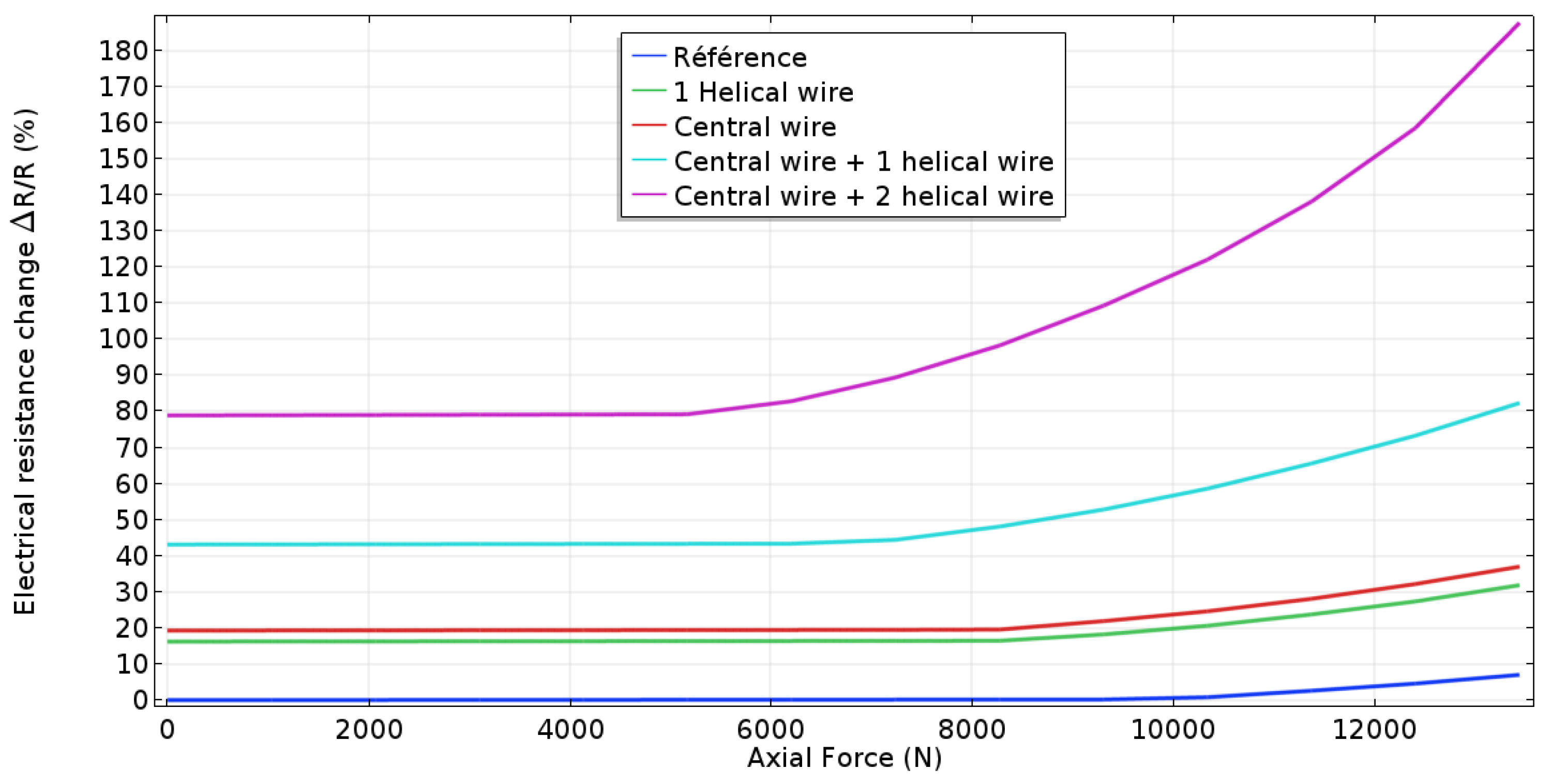
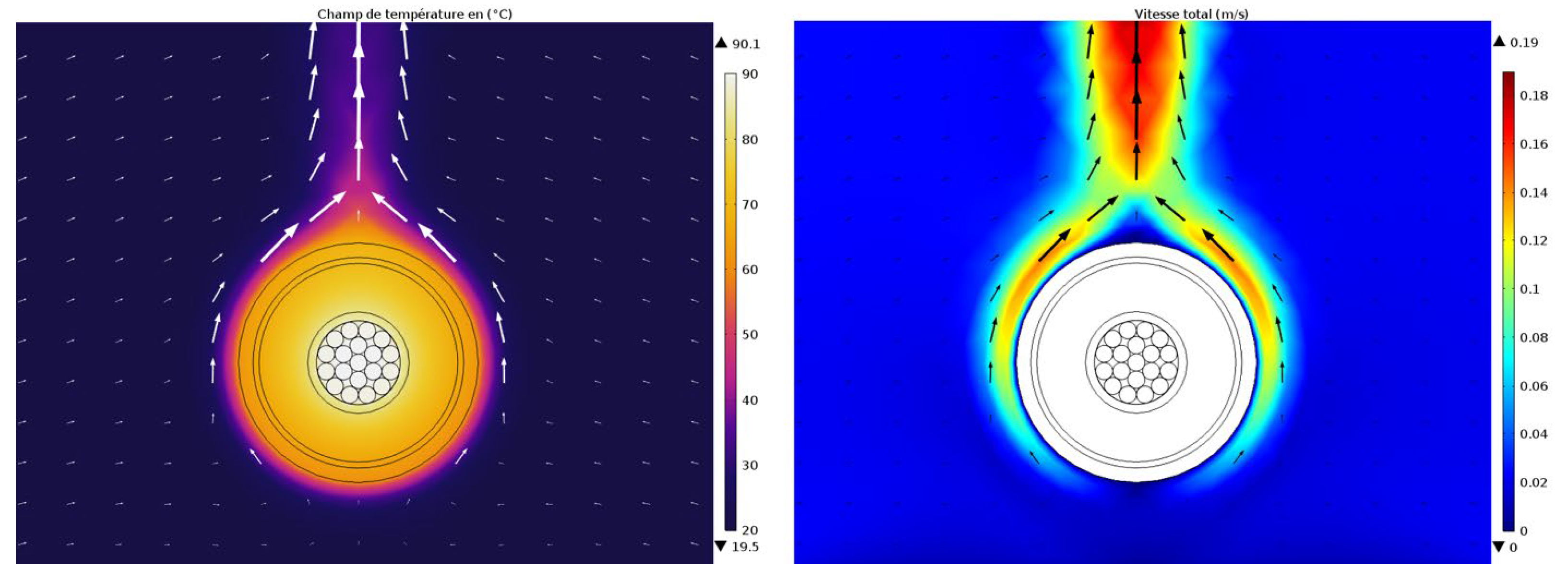
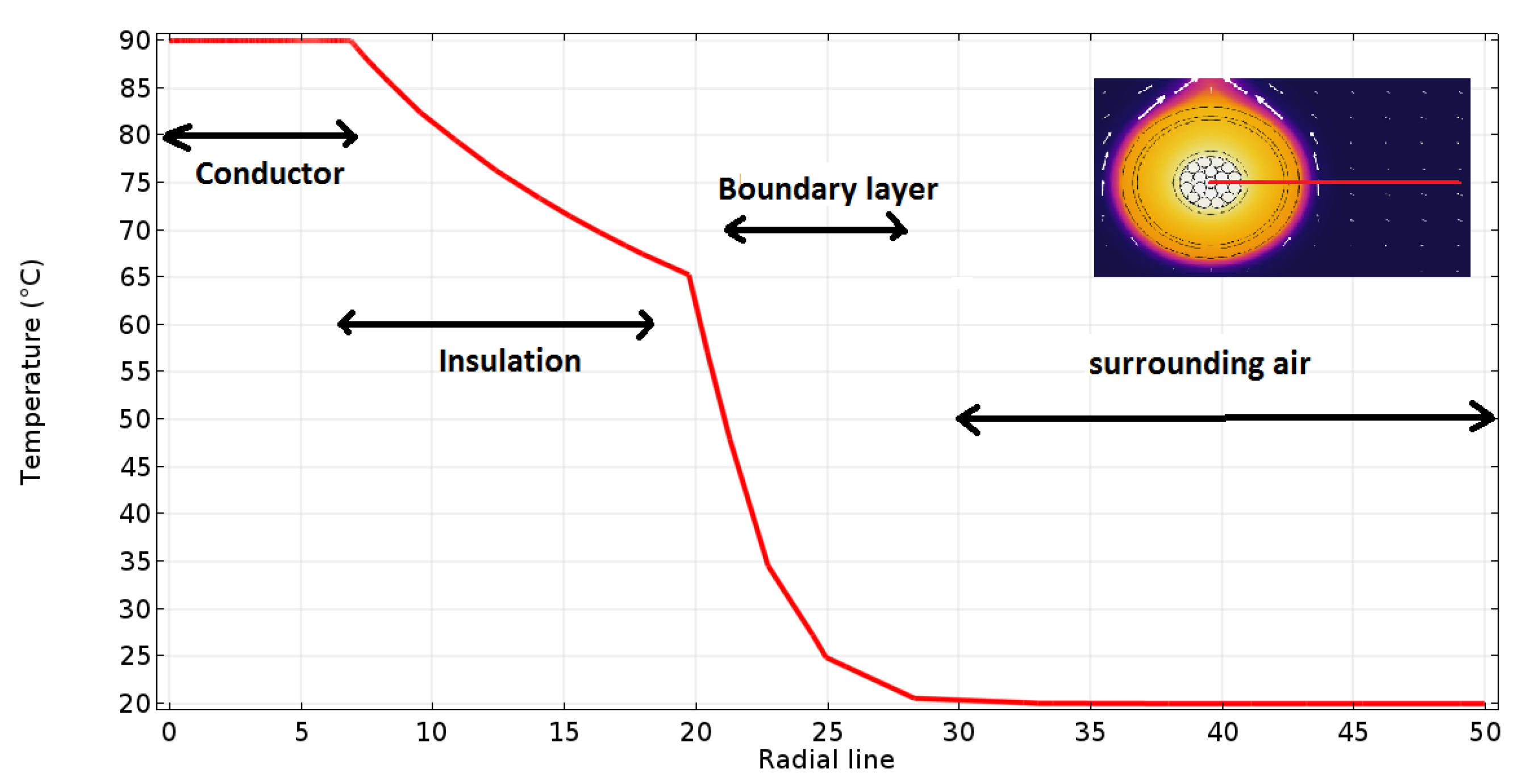
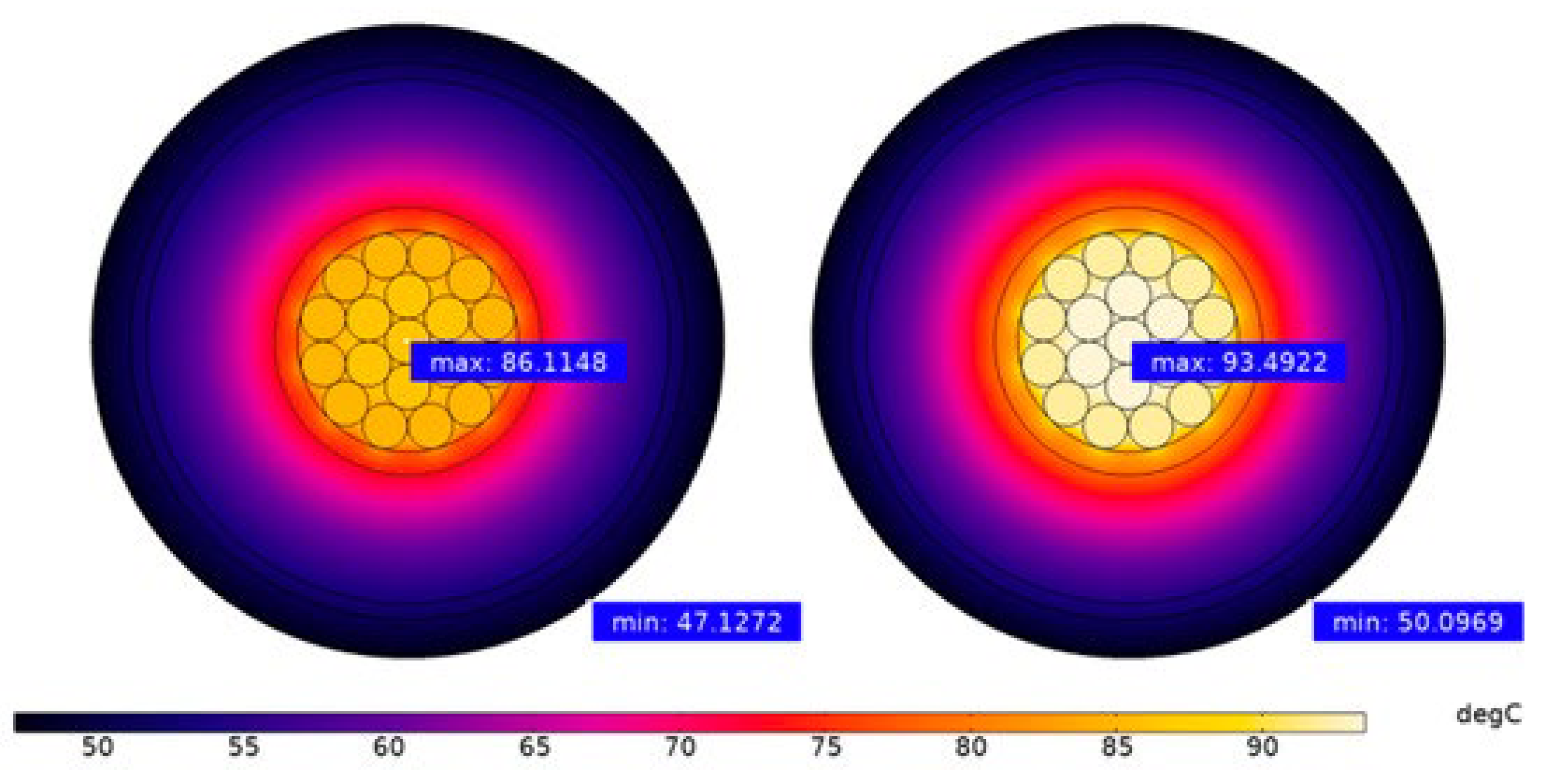
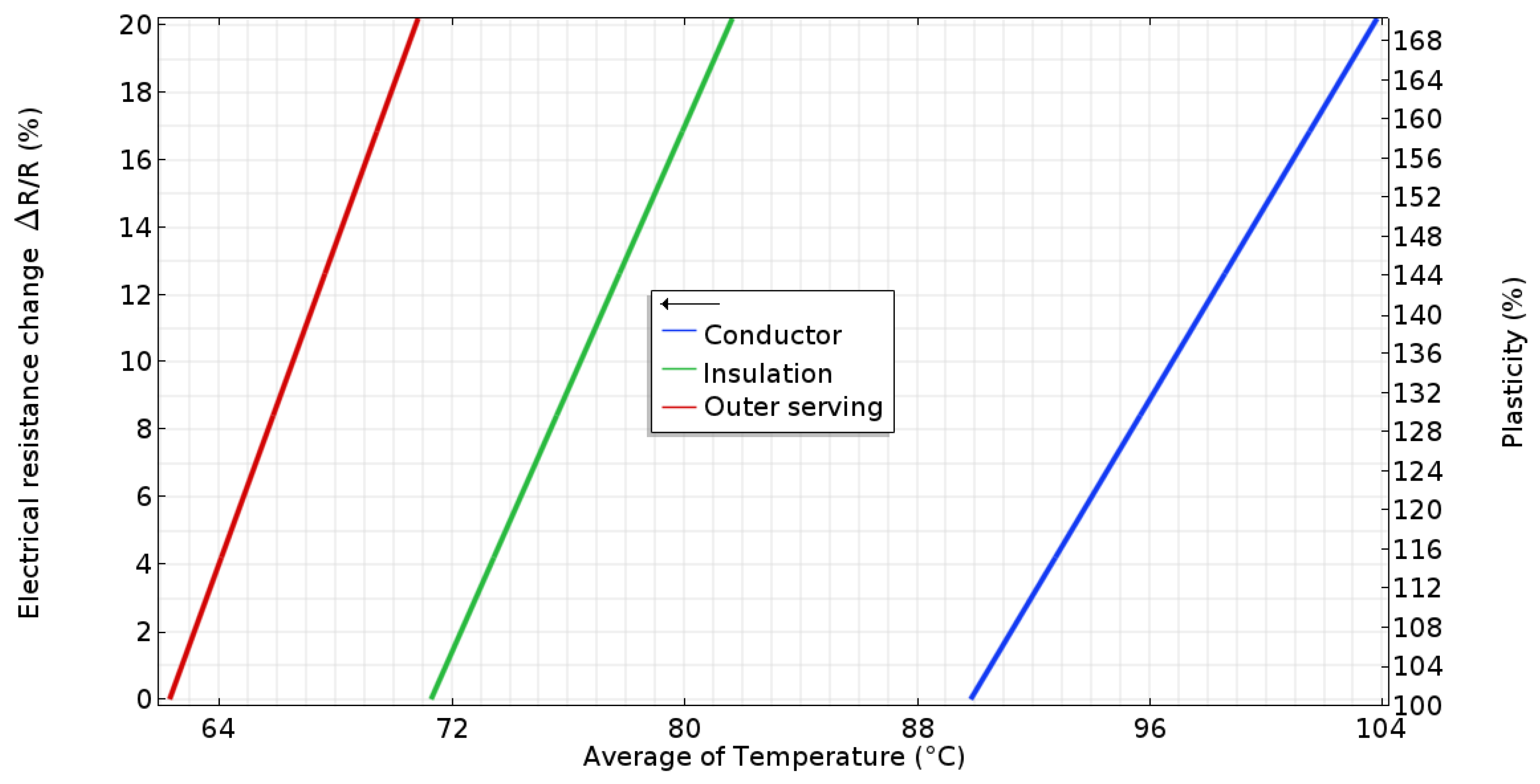
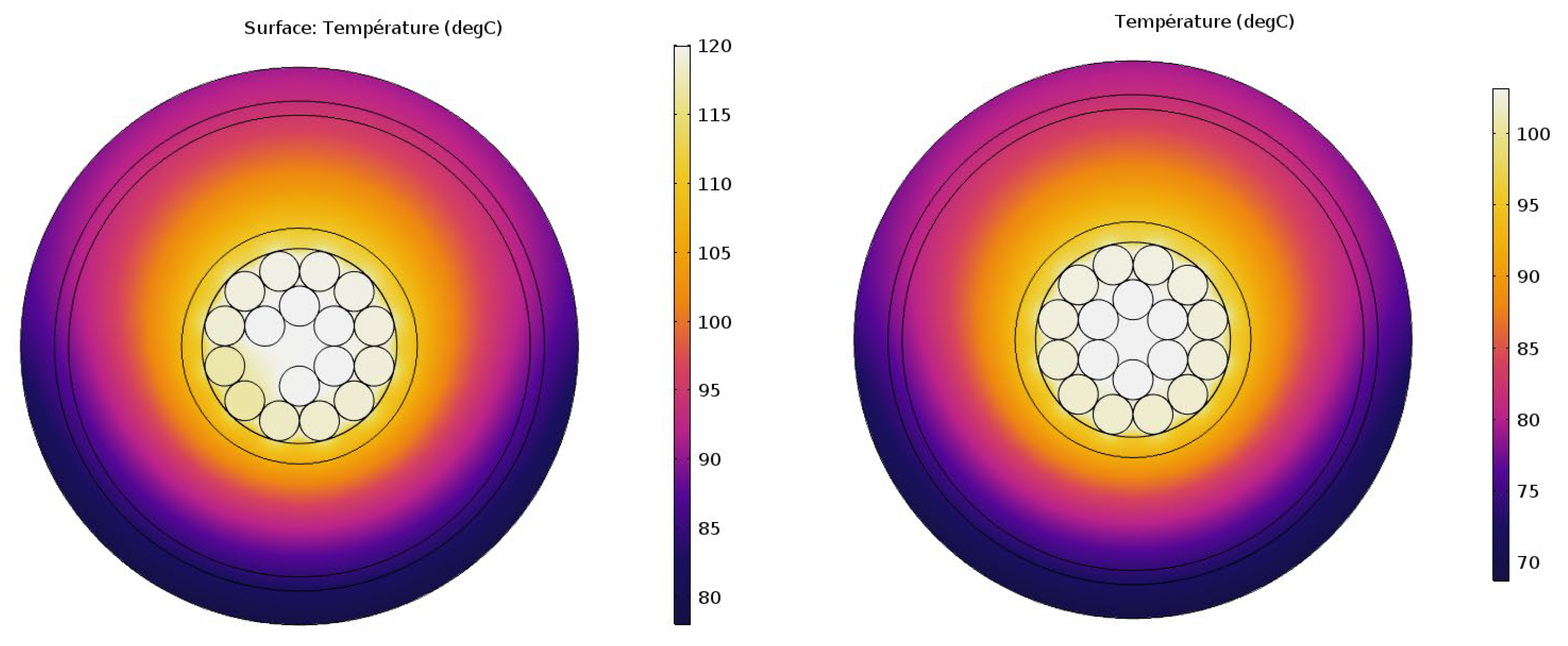


| Component | Material | Young’s Modulus (GPa) | Poisson’s Ratio | Thermal Conductivity (W/k.m) | Volum Thermal Capacity [MJ.m-3 K-1] | Thickness (mm) |
|---|---|---|---|---|---|---|
| Conductor | Copper (Cu) | 115 | 0.3 | 370.4 | 3.45 | Diameter: 13 |
| Semi-conductor | XLPE | 0.34 | 0.34 | 0.28 | 2.4 | 1 |
| Insulator (XPLE) | Cross-linked polyethylene (XLPE) | 0.35 | 0.4 | 0.28 | 2.4 | 8 |
| Sheath | High-density polyethylene (HDPE) | 1.38 | 0.42 | 0.28 | 2.4 | 2.4 |
| Number | Radius `(mm) | Young’s Modulus (GPa) | Poisson’s Ratio | Unwounded (mm) | Elastic Limit (MPa) | Strength (MPa) | Electric Conductivity (S/m) | |
|---|---|---|---|---|---|---|---|---|
| Central wire | 1 | 1.97 | 115 | 0.33 | ************ | 135 | 340 | 5.9 |
| Helical wire (1st row) | 6 | 1.865 | 115 | 0.33 | 210 | 135 | 340 | 5.9 |
| Helical wire (2nd row) | 12 | 1.865 | 115 | 0.33 | 210 | 135 | 340 | 5.9 |
| Constituents | Mean Temperature (°C) |
|---|---|
| Conductor | 89.94 °C |
| Semi-conductor layer | 82.79 °C |
| XPLE | 71.29 °C |
| Semi-conductor layer | 64.53 °C |
| Sheath | 62.30 °C |
| Constituents | Mean Temperature (°C) Central Wire Failure | Mean Temperature (°C) With Failure of 2 Wires | Mean Temperature (°C) With Failure of 3 Wires |
|---|---|---|---|
| Conductor | 104.42 °C (+16.1%) | 118.95 °C (+32%) | 145.01 °C (+61%) |
| Semi-conductor layer | 96.01 °C (15%) | 109.23 °C (+31%) | 133.03 °C (+60%) |
| XPLE | 82.09 °C (+15%) | 92.89 °C (+30%) | 112.34 °C (+57%) |
| Semi-conductor layer | 73.91 °C (+14%) | 83.28 °C (+29%) | 100.16 °C (+55%) |
| Sheath | 71.21 °C (+14%) | 80.11 °C (+28%) | 96.15 °C (+54%) |
| Temperature variation | 14.8% | 30% | 57% |
Disclaimer/Publisher’s Note: The statements, opinions and data contained in all publications are solely those of the individual author(s) and contributor(s) and not of MDPI and/or the editor(s). MDPI and/or the editor(s) disclaim responsibility for any injury to people or property resulting from any ideas, methods, instructions or products referred to in the content. |
© 2023 by the authors. Licensee MDPI, Basel, Switzerland. This article is an open access article distributed under the terms and conditions of the Creative Commons Attribution (CC BY) license (https://creativecommons.org/licenses/by/4.0/).
Share and Cite
Ech-Cheikh, F.; Matine, A.; Drissi-Habti, M. Preliminary Multiphysics Modeling of Electric High-Voltage Cable of Offshore Wind-Farms. Energies 2023, 16, 6286. https://doi.org/10.3390/en16176286
Ech-Cheikh F, Matine A, Drissi-Habti M. Preliminary Multiphysics Modeling of Electric High-Voltage Cable of Offshore Wind-Farms. Energies. 2023; 16(17):6286. https://doi.org/10.3390/en16176286
Chicago/Turabian StyleEch-Cheikh, Fouad, Abdelghani Matine, and Monssef Drissi-Habti. 2023. "Preliminary Multiphysics Modeling of Electric High-Voltage Cable of Offshore Wind-Farms" Energies 16, no. 17: 6286. https://doi.org/10.3390/en16176286
APA StyleEch-Cheikh, F., Matine, A., & Drissi-Habti, M. (2023). Preliminary Multiphysics Modeling of Electric High-Voltage Cable of Offshore Wind-Farms. Energies, 16(17), 6286. https://doi.org/10.3390/en16176286








